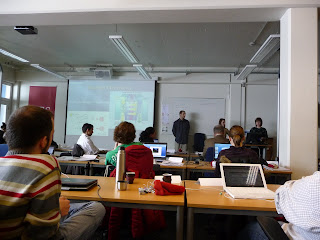Life Cycle Assessment & Energy Efficiency Analysis was the topic for this week’s course. Dr. Paulo Ferrao of MIT Portugal led us through the basics of life cycle analysis and the concept of industrial ecology. I’ve heard a lot about bio-mimicry where nature inspires the design of a product (the bone structure of fish for vehicle frames, modeling hurricanes to improve propeller design, etc.) but industrial ecology was especially interesting as it was a systems approach which didn’t copy a specific design from nature, but rather how processes and components should interact with each other and the surroundings as a whole. The project for this week involved assessing the impact of energy created from wind turbines compared to that of other energy sources.
This week also brought some of the first real hints of spring. Although there was still a ton of snow, it was sunny and warm enough to take a bike out and explore a little bit around Skjaldarvik.

Over the weekend was out second big trip as a group. We took two vans and headed across the fjord and north to the quite town of Grenivík where we had reservations to take a snow cat up the mountain called Kaldbakur. It was a relatively short drive and we had the van for the whole day so we took our time getting there. On the way, we stopped at Laufás, which had some very cool sod houses and a nice church. Unfortunately, they were closed for the day but it was still fun to walk around and explore a bit.

When we made it to Grenivík, we went to the coast and had lunch and walked around. We had to kill a couple of hours until we were scheduled to go up the mountain so we decided to see how far we could continue driving north. Turns out, not so far but we were able to hike around the side of the fjord.

After some time, we drove to where we meet the snow cat driver. He pulled up in a huge 4x4 and even had a wireless credit card machine for everyone to pay. Luckily, he had enough extra sleds for us so we did not have to go down the mountain on the baking pans and trash bags as we had originally thought we might. There were two snow cats and each had a few rows of benches in the back. We jumped in and starting to drive up the mountain.

Wow. I still cannot believe how amazing this was. The weather was perfect and you could see for miles (which is saying a lot for being in Iceland). I was so in awe I ended up taking about 150 pictures in about an hour.

Once on the top, we took some more pictures including a group shot and of course some jumping shots.



Now, it was time to start the decent.

Turns out, sledding really fast down a mountain for about 6km can kick a lot of snow in your face. But, some were more prepared than others.

The snow was a little bit hard and it was difficult to hold an edge. I was bold/stupid enough to try to ride down holding my camera while continuing to take pictures. Luckily, I didn’t crash! Some others were not so fortunate and a few even lost their sleds in the wind and off a cliff. When we finally made it to near the parking lot area, the sun was just starting to set. We had an impromptu snowball fight, took another group picture, and loaded up to head back to Akureyri.




 It seems like the weather in Iceland is unpredictable at best. Our trips to the environs around town have shown how drastically the weather can turn from sunny to snowing to sideways rain, all over the course of a few kilometers. However, this week seemed to be snow, and lots of it. The above picture shows a rare clear afternoon. The view is of the Kjalarsida apartments in the foreground and the ski resort, Hliðarfjall, in the background. If you look closely on the second floor, you can almost make out how clean my place is.
It seems like the weather in Iceland is unpredictable at best. Our trips to the environs around town have shown how drastically the weather can turn from sunny to snowing to sideways rain, all over the course of a few kilometers. However, this week seemed to be snow, and lots of it. The above picture shows a rare clear afternoon. The view is of the Kjalarsida apartments in the foreground and the ski resort, Hliðarfjall, in the background. If you look closely on the second floor, you can almost make out how clean my place is.




















